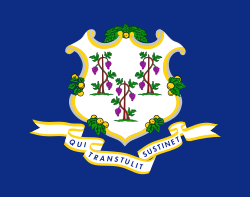Top Qs
Timeline
Chat
Perspective
Flag of Connecticut
U.S. state flag From Wikipedia, the free encyclopedia
Remove ads
The flag of the U.S. state of Connecticut is a white baroque shield with three grapevines, each bearing three bunches of purple grapes on a field of royal blue. The banner below the shield reads "Qui Transtulit Sustinet," Latin for "He who transplanted sustains," Connecticut's state motto. The flag dimensions are 5.5 feet (1.7 m) in length and 4.33 feet (1.32 m) in width.[1]
Remove ads
History
Summarize
Perspective
The first state flag was adopted during the American Civil War. The banner was described as: "The field of the flag adopted was a deep blue, and the three vines, which had been on the Connecticut flag from the outset, were on a groundwork of white." Its nickname was Blue Peter, and it was usually hanging in the halls of the Old State House.[2]
In 1897, the Connecticut General Assembly approved a new flag after it was introduced by Governor Owen Vincent Coffin in 1895.[1] Abby Day Slocomb, the regent of the Anna Warner Bailey chapter of the Daughters of the American Revolution, submitted the design.[3][4]
In 1900, the New York Society of Sons of the Revolution sent the historic Nathen Hale schoolhouse to the Connecticut Society Sons of the Revolution.[5] One year later, members of the society got permission to move and restore the building. To celebrate the restoration, the society invited Governor McLean and some companies of the National Guard to celebrate. The men carried with them a state flag and a state banner.[6] The banner design was not described, but it most likely flew vertically.
The design comes from the seal of Saybrook Colony, designed by George Fenwick when it was established in 1639. That seal depicted 15 grapevines and a hand in the upper left corner with a scroll reading "Sustinet qui transtulit." When the Connecticut Colony bought Saybrook in 1644, the seal transferred to the Connecticut Colony. On October 25, 1711, the governor and legislature changed the seal. They reduced the number of grapevines from 15 to three, to represent the three oldest settlements (Windsor, Wethersfield, and Hartford)[7] (or possibly the three separate settlements, Connecticut Colony, Saybrook Colony, and New Haven Colony, which had been absorbed into Connecticut by that time) and rearranged the wording and position of the motto.
Gallery
- Digital reconstruction of the state flag flown during the Civil War[2]

- Early state flag
- The Connecticut state flag as depicted in the 1976 bicentennial postage stamp series.
Remove ads
Flying the flag at half staff
Customarily, the flag of Connecticut is flown at half-staff when the federal flag is, which may be ordered by the President or the Governor.[8] According to 2007-R-0624, only the governor of Connecticut may decide that the state flag should be flown at half-staff, though the right is a power of office and not a law.
Typically, the state flag is flown at half-staff upon the death of a Connecticut resident serving in the armed forces,[9] upon the death of a former governor or serving member of the state legislature, or for an event of great sorrow for Connecticut.[10]
Remove ads
Historical flags used in Connecticut
- The naval Red Ensign of the former Kingdom of England, from which the flags of New England are derived.[11]
- The First Flag (and Ensign) of New England used by merchant ships sailing out of New England ports.
- After the union of England and Scotland, some New England ensigns used the British Union Flag rather than St. George's Cross.[12]
- The Flag of New England with St George's Cross removed.[13]
- The Flag flown during the Dominion of New England, using the personal standard of Edmund Andros
See also
References
External links
Wikiwand - on
Seamless Wikipedia browsing. On steroids.
Remove ads










